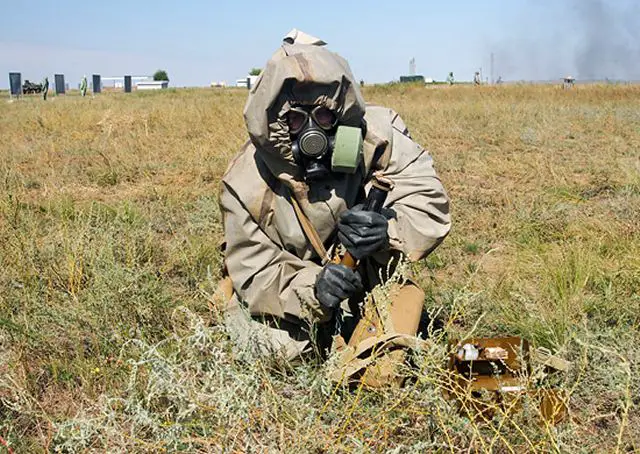Russian Army Chemical combat units will receive new CBRN protective kits TASS 11903172
|
|
|||
|
Military Defense Industry Technology - Russian Chemical Corps
|
|||
|
|
|||
| Russian Army Chemical combat units will receive new CBRN protective kits. | |||
|
The Russian Army Chemical Corps and the regiments being activated to conduct man-made and natural disaster relief operations at the Defense Ministry’s installations will be issued protective kits that will afford the wearers virtually total invulnerability to chemical agents, radioactive dust and biological weapons, according to the Izvestia daily.
|
|||
|
|
|||
 Russian soldiers with CBRN protective clothing during military exercise in Russia. |
|||
|
|
|||
| The protective clothing from the Kazan Chemical Research Institute (KKhNII) will enable the troops to spend hours in areas contaminated by weapons of mass destruction (WMD) or hit by man-made disasters or handle toxic substances in a safe manner. The gear is a gas-proof one-piece protective garment with an airtight zipper. It is made of a flame- and deleterious substance-resistant material and equipped with an advanced breather housed by a protective armored casing. "Currently, the suit is in the manufacturer’s trials," KKhNII Spokesman Rustem Khayapov told Izvestia. "It will be unveiled as early as 2017." A CBRN soldier clad in the up-to-date superprotective kit will be able to operate in a cloud of chlorine or ammonia for 10 hours at a stretch or withstand concentrated sulfuric, hydrochloric or hydrofluoric acid for eight hours. The suit also allows three hours of working with heptyl or amyl. The service life of an ordinary protective kit in a contaminated area is one hour at the most. Besides, standard-issue models do not guarantee 100% protection against such highly toxic substances as heptyl and amyl - popular components of rocket propellants that corrode rubber almost instantly and are Class I in terms of hazard. KKhNII’s latest product is reusable. Once decontaminated with water or chemical solutions, it can be worn again. The kit will be used in conjunction with a special overpressure breather that will supply air. "In spite of major world powers having disposed of their chemical agent stockpiles, the threat posed by chemical weapons persists," expert Leonid Karyakin told the Izvestia daily. "Some of the third-world countries have stockpiled plenty of chemical agents. Chemical weapons have been used proactively during the fighting in Syria and Iraq. For instance, the militants, who have recently assaulted a district in Aleppo, used makeshift rockets filled with chlorine and white phosphorus." "Mobile robotic systems capable of substituting for humans on disaster-relief operations have not been developed yet, and man has to shoulder all operations like that," Karyakin explained. "A good case in point is the nuclear disaster at Japanese nuclear power plant the Fukushima-1, which showed that the disaster fighters’ protective equipment hails from the Chernobyl disaster times." |
|||
|
|
|||
|
© Copyright 2017 TASS. All rights reserved. This material may not be published, broadcast, rewritten or redistributed.
|
|||


























